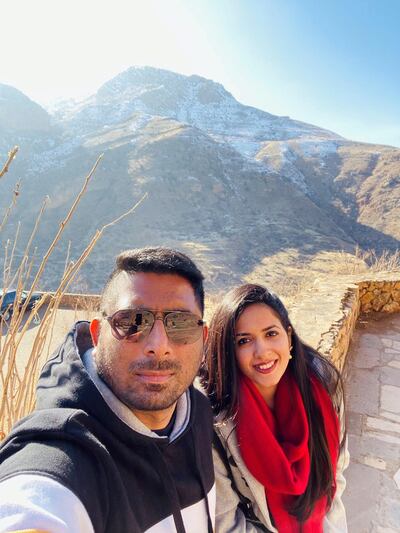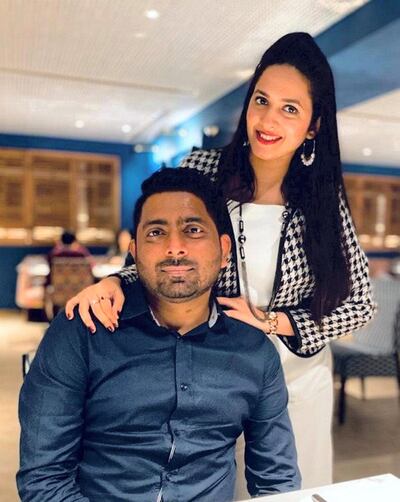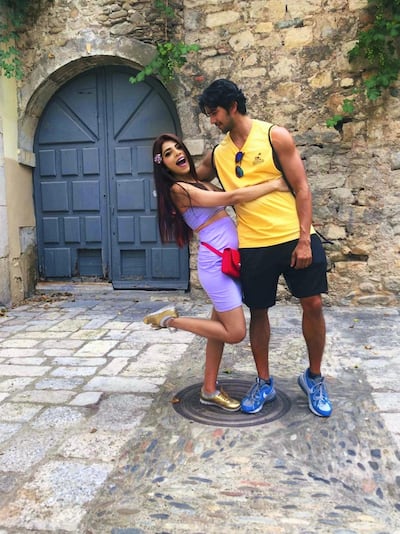Few shows have been as divisive and controversial as Netflix's recent Indian Matchmaking.
The series, which follows Mumbai matchmaker Sima Taparia as she connects Indian-origin singles looking for spouses, has been praised criticised, inside India and beyond.
While many say it perpetuates – and even normalises – damaging ideas around colourism and caste, others are of the opinion that it simply shines a light on the reality of Indian set-ups, while doing what reality television does best: entertain.
Is the show hyper-dramatised? Or does it provide relatable content for modern Indians? We speak to four UAE couples who met through arranged marriages to find out.
'Conversations on arranged marriages are maturing'
Nasera Anjum and Mohammed Abdul Shadab met through a matrimonial advertisement in a newspaper – a standard practice for those in their community in Hyderabad, India. Mohammed was working in IT in the UAE at the time, while Nasera was a teacher in India, so it was during a trip back home that they first met face-to-face.
“The meeting was very formal, in front of his family,” Nasera says. “He was pretty flamboyant, talkative. I was more reserved, just answering questions.”
Phone numbers were exchanged, Mohammed returned to the UAE, and the two kept in touch. However, after a few weeks of talking, both of them told their parents it wasn’t working out.
“When we started talking, our personalities didn’t match. I’m a social person. I like partying, meeting friends; she’s more homely. I thought I would lose all my freedom,” Mohammed says, with a laugh.
But both sets of parents were disappointed, and asked them to keep an open mind. “My mum told me that he seemed nice and asked me to speak to him for a bit longer,” says Nasera. “We eventually fell in love. We got engaged in three months.”
The second time the couple met face-to-face was at their wedding. Even their engagement was done virtually, since they were in different countries.
The couple have now been married for five years. Mohammed believes that their example is proof that arranged marriage in India is evolving. In the past, it was standard for families to arrange marriages – sometimes without the bride and the groom even meeting or speaking before the engagement. Now, the bride and groom are more actively involved, and are having deeper conversations, the couple says.
“I think the conversation around arranged marriage is maturing. When Nasera and I used to speak, we would talk about things like the future, how we wanted to build careers, travel. I think couples are having these conversations rather than just asking general questions,” says Mohammed.
Verdict on 'Indian Matchmaking'
Nasera: I think it's realistic. Sima Taparia is more elite, visiting people in their homes, but there are marriage bureaus that people approach for these kinds of services. They submit their profiles, or biodata, and have six-month or year-long packages, during which the bureaus will send over profiles to the bride and the groom. If a match is made, both the bride and the groom pay a sum.
Meeting on a matrimony website
Archana Sadanand and Pradeep K Nambiar’s story is something many urban, millennial Indians will relate to. “When I turned 25, my relatives started nosing around and asking my parents why I hadn’t found anyone yet. So, I told my parents they could make a matrimony profile to get them off my back,” says Archana, an influencer.
Meanwhile, Pradeep’s parents had made a profile for him five years previously, which is how the two ended up meeting through Keralamatrimony.com.
“My parents were handling my profile, but they would show me some matches that showed interest. I was drawn to his. It seemed honest and he was handling it himself at the time,” says Archana.
The parents got involved at that point to match horoscopes, a standard practice in their community in Kerala, before passing on contact numbers. Because they lived close to each other, they met for the first time in a nearby McDonald’s restaurant.
“The meeting was nice; the conversation felt so normal,” says Archana. “After that we started meeting every two days, then every day.”
After hanging out for three months, they told their parents how they felt, the family connected, and the two got engaged. For Archana, it didn’t seem too fast. Because they were both meeting up by themselves, with little involvement from their parents, it didn’t even feel like an arranged marriage.
“People are always so shocked at the idea of an arranged marriage, but how is this any different to meeting on a dating website? At least when you meet on a matrimonial website, you know that both parties are serious about an end goal, and want to see the relationship going somewhere,” she says.
Verdict on 'Indian Matchmaking'
Archana: It was cringe-worthy but also really entertaining. I would love to see a season two. I hope the people on the show realise how they look to the outside world. I don’t think it’s an accurate representation of arranged marriage. I think it’s a reality show at the end of the day and if it’s not controversial, it’s not successful, so the show’s creators went for extreme scenarios.
Making the first call
In many parts of India, churches have a centre that provides a matchmaking service, which is how Divya Lobo and Praveen D’Souza met. They were in Bengaluru at the time, and they had both registered at their local church. The family connected through the service, passed along phone numbers, and it was Divya who made the first call.
“That was a bit unusual, in an arranged set-up, for the girl to be the first to call,” says Praveen. “We planned a meeting at a local coffee shop.”
Unlike traditional arranged set-ups, Divya hadn’t seen Praveen’s picture while organising the meeting. The night before, she messaged him to ask if he could send her a photo of himself. “A lot of people doctor these photos anyway, to make themselves look a certain way. It wasn’t a priority for me,” says Divya.
The meeting took an unexpected turn when the coffee shop turned out to be full, which led them to a nearby cafeteria. After the meal, Praveen realised he didn’t have any cash and since the cafeteria didn’t accept cards, Divya paid for the meal. They parted ways, but Praveen then realised he didn’t have any money to pay for parking either. “I had to call her up and ask if I could borrow money for parking,” he says, laughing.
“I never got that money back,” Divya adds.
In their community (they are both from Mangalore), it is common for couples to meet independently before they decide to introduce each other to their parents. In Praveen and Divya’s case, her parents first met him separately, without his family, and took a liking to him. The couple kept in touch over the phone, met frequently, were engaged within two months and married within six. They’ve now been married for nine years, and have a 4-year-old son.
“I think the concept of arranged marriage is getting more broadminded, especially in some communities,” says Praveen. “I think the important factor is whether someone is meeting people because they want to get married or because their parents want them to get married. If it’s the parents, it becomes more traditional. But, in our case, we were driving things forward. It didn’t feel very traditional.”
Verdict on 'Indian Matchmaking'
Divya: It’s pretty realistic. In the show, the matchmaker sets people up, and then they go on dates to figure out whether they like each other; the latter part was similar for us. I thought some of the show's characters, like Nadia for instance, were very relatable.
Technology has been a game-changer
Like some of the stars in Indian Matchmaking, Mohit and Jogan Bhojwani are Sindhis, an ethnic group with roots in Sindh, Pakistan. While they're familiar with the process of an arranged marriage, as depicted on the show, their story was quite different.
Like most modern-day couples, Mohit and Jogan were introduced through someone they both knew.
“A relative from my dad’s side knew Mohit, who she thought would be a good fit for me. Initially I was hesitant; I wanted to continue living in Mumbai and he was in Dubai. I thought about it for a few days and then figured I might as well give it a try,” says Jogan.
Phone numbers were exchanged and the pair started texting each other; they connected online and their communication continued virtually for three months. The first time they met face to face was when Mohit went to Mumbai for a holiday in 2017, and Jogan picked him up from the airport.
Their case isn't traditional for their community, and is considered more of a love marriage – neither of their families believed in matching horoscopes, so they eschewed that part as well. Although they have seen plenty of traditional marriages within the community, things are changing, they say.
“Technology has changed things,” says Mohit. “Earlier people would trust their parents completely to make that match; they wouldn’t even meet their future partner. But with WhatsApp and social media, it’s impossible not to communicate. Not only do couples talk every day, they follow each other on Facebook, Instagram, and they know their friends and inner circles well before the marriage. It’s impossible not to be in touch.”
Verdict on 'Indian Matchmaking'
Mohit: It was pretty accurate. When it comes to arranged marriages, people can be really picky, sometimes even stating whether they want spouses who are self-made or come from a family business.
And, in the beginning, they are judged on the basis of their biodata, so the book is judged by the cover. While that is unfortunate, it does also speed the process up sometimes as people know exactly what they’re looking for. In fact, the idea of biodata is similar to dating apps, where people swipe according to looks. At least over here, there are background checks, more understanding of the person and what they’re looking for.









